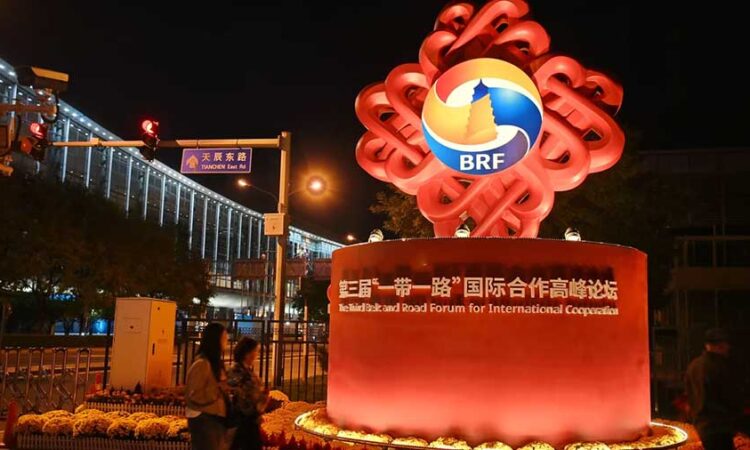
By Emil Avdaliani
The Third Belt and Road Forum held in Beijing last week witnessed participation from over 4,000 individuals representing more than 140 nations. By the conclusion of the forum, cooperation projects totaling US$97.2 billion were inked. China released 89 multilateral cooperation documents and detailed 458 concrete cooperative initiatives. More wide-ranging, the Forum signals a notable shift in China’s investment strategy and the future participation of Chinese companies.
One of the highlights of the event was the announcement of the Global Artificial Intelligence Governance (GAIG) Initiative which follows Beijing’s earlier ventures such as the Global Development, Security, and Civilization Initiatives. According to the official statement, GAIG focuses on preventing the creation of ideological barriers or exclusive groups that hinder AI development in other nations. The timing behind the unveiling the initiative is interesting as it coincides with Washington’s recent decision to restrict China’s access to sophisticated chip technologies.
In addition to the initiative on AI during the opening ceremony of the Forum, Xi Jinping, the Chinese President unveiled another seven new strategic objectives:
Europe-Asia Logistics Corridor: Enhance connectivity, addressing bottlenecks and potentially aligning the BRI with the EU’s ‘Global Gateway’ program, emphasizing collaboration over rivalry.
Silk Road E-Commerce Zone: The launch of an updated digital platform to facilitate trade, updating and adding to existing treaties to match current technological needs.
Financial Commitment: An extra US$47.8 billion pledge from Chinese banks, adding to the US$1.1 trillion already dedicated over the last decade.
Green Development Focus: Prioritizing sustainable investments in conjunction with the BRICS New Development Bank (NDB) and in line with China’s environmental objectives.
Cultural Exchanges and Tourism: Develop a cross-border tourism alliance, especially with Central Asia and the Middle East, promoting interactions and potentially joining the Organization of Islamic Cooperation.
Transparency and Clean Cooperation: Addressing negative perceptions by promoting transparency, focusing on sustainable technologies, and ensuring overseas investments adhere to compliance standards.
BRI Institutions Formation: Aim to create a centralized BRI institution to inform about projects, aiding foreign investors in understanding potential opportunities within the BRI framework.
To facilitate the Belt and Road projects, China’s two key policy banks, the China Development Bank and the Export-Import Bank of China, will each dedicate 350 billion Yuan (around US$48 billion) for funding. The state-backed Silk Road Fund will contribute an additional 80 billion Yuan (about US$11 billion).
From the contents of the signed documents, it is clear that Beijing’s vision for the Belt and Road Initiative (BRI) is evolving towards more sustainable and technologically advanced initiatives, transitioning from large-scale projects such as constructing dams, to focus on digital finance and e-commerce systems.
Pakistan

China and Pakistan also strengthened their commitment under the CPEC aspect of the Belt and Road Initiative. An agreement was reached to launch a major railway project in Pakistan, valued at US$7 billion. The ML-1 railway initiative is a 2,600-kilometer link from Peshawar to Karachi which is expected to significantly increase train frequency and speeds. This agreement anticipates an influx of Chinese investment exceeding US$65 billion across various sectors in Pakistan.
Serbia

Additionally, a free trade agreement was finalized between Serbian Trade Minister Tomislav Momirovic and Chinese Commerce Minister Wang Wentao. Serbia also disclosed the signing of three contracts with Chinese firms, totaling nearly €4 billion and which focus primarily on road construction and the procurement of Chinese high-speed trains. Serbia has a Free Trade Agreement with Russia via the Eurasian Economic Union, and has long been a recipient of BRI funding of projects – much to the annoyance of the European Union.
Hungary

In a related move, China’s National Development and Reform Commission (NDRC) has signed five agreements with Hungary on mutual efforts to promote the BRI. Additionally, both parties secured four more memorandums of understanding to boost mutual cooperation in industrial investment, policy exchange for economic growth, sustainable and low-carbon development, and the digital economy. The Hungarian Foreign Minister Peter Szijjarto, has been critical of the European Union (Hungary is part of the EU) and its relationship with China, stating that “Unfortunately, there are Western Europeans… who strive to cut off economic cooperation between Europe and China. If this were to happen, it would practically be a knockout blow to the European economy. That is why we are against any effort to isolate the Chinese and European economies from each other.”
Viktor Orban, the Hungarian Prime Minister, met with Russian President Vladimir Putin at the Forum, also commenting on Budapest’s unhappiness at Brussels current position as regards China. Orban was the only EU leader to attend the Forum, others delegated attendance to Ambassador-level ranks or did not show up.
European Union

China’s relationship with EU is complex – and competitive, despite Xi also stating that China would be happy to work with Brussels in coordinating and possibly being jointly involved in BRI – Global Gateway Projects. Yet the timing says it all. Nearly coinciding with the BRI forum, the EU is holding the Global Gateway Forum in Brussels on October 25-26. In comparison, it will host leaders from around 20 countries including the heads of Bangladesh, Namibia, Senegal, and Moldova. In particular, two memorandums of understanding between the EU and the DR Congo, and Zambia may be signed at the forum, which will give Europeans access to critical raw materials and allow to develop a transport corridor in Africa, which will connect Eastern Africa with the Angolan port of Lobito on the Atlantic coast.
China has now surpassed the EU in terms of GDP. Its share of global GDP jumped from 9% in 2010 to the current 18%, while the EU’s share has dropped from 22% to 17%.
Hungary’s Foreign Minister said that “The overall structure of the world economy is being transformed, and this great transformation also means that the West’s automatic competitive advantage has ended. The Eastern world has strengthened significantly, they have at the very least caught up with the Western world from a financial and technological point of view, while they have always been ahead of us in terms of human resources. The Eastern and Western economies are more strongly interdependent nowadays than ever before; the EU should not shy away from this trend. Whether we like it or not, it’s a fact. Whoever denies all this can cause very serious damage to the European economy.”
Russia

Another major project China has been working on is the Power of Siberia 2 – a major pipeline from Russia which will traverse Mongolia. However, despite intensive negotiations, no major progress has been reported. As China is making serious strides toward renewable energy, investing into this project will be a tough sell for Moscow.
Summary
Despite doubts about the vitality of the BRI expressed in the West, the initiative remains a priority for China. However, its future approach is expected to differ from its initial decade (2013-2023). Chinese banks have recognized the complexities of infrastructure investments, especially in developing nations. The evolving strategy for BRI will likely be more streamlined, strategic, and cost-conscious, favouring less risky ventures over projects with better cash-flow potential and less political risk. BRI investments have already slowed down, averaging US$392 million in the first half of the current year, a 48% drop since 2018.
The BRI is driven by economic objectives. Data from China’s Ministry of Commerce highlights that trade between China and Belt and Road nations doubled from US$1.04 trillion in 2013 to US$2.07 trillion in 2022. As of June 2023, China ratified over 200 BRI-related agreements with 152 nations and 32 global institutions.
This year’s forum emphasized themes like connectivity, green growth, and the digital economy, indicating China’s evolving vision for BRI. The focus will likely shift from traditional infrastructure projects like railways and ports to digital connections, standardizations, educational programs, and cultural exchanges. China’s private enterprises are also venturing into areas previously dominated by policy banks and state-controlled entities.
Moving forward, the 2023 forum signals two major shifts. China is expected to be more conscious of debt sustainability of those seeking engagement with the BRI. Chinese financial bodies may curtail their involvement in projects which bear risk. Investing in railways and ports, however, will remain central to the idea of BRI. Another likely major change is the growing participation of Chinese private enterprises. BRI proved its viability over the course of the past decade, and this will likely serve as a major incentive for private Chinese companies to invest abroad.
Emil Avdaliani is a professor at European University and the Director of Middle East Studies at the Georgian think-tank, Geocase.
Related Reading
About Us
Silk Road Briefing is written and produced by Dezan Shira & Associates. As global geopolitics change the way supply chains are developing, we provide regional analysis of the emerging trends and where opportunities for foreign investors are. Our firm provides market research and intelligence for issues affecting all the Belt and Road Initiative countries with assistance from our wide business network of over 100 regional offices. To learn more about how we can help your business evaluate the changing dynamics, email us at [email protected] or visit www.dezshira.com





